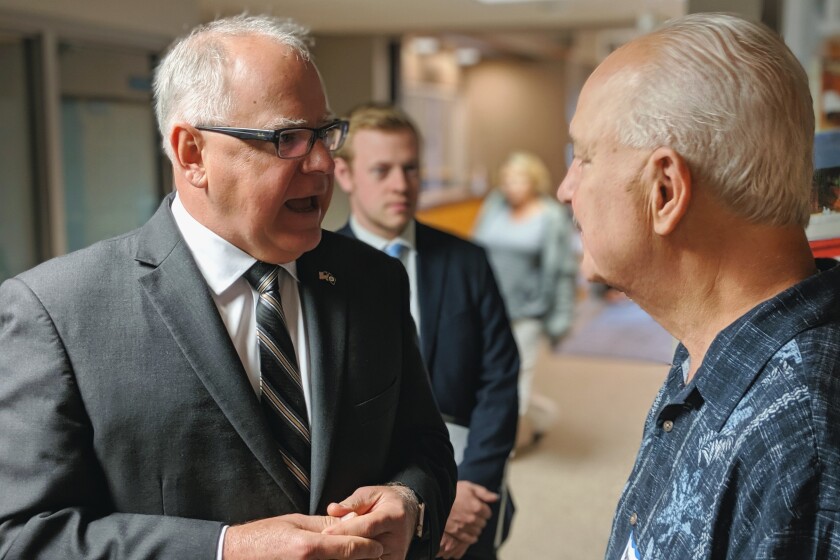In terms of local government aid, 2019 was a red-letter year that set the stage for the Coalition of Greater Minnesota Cities to push other issues it believes are hampering communities in rural outstate areas — most prominently, a hefty 2020 bonding bill to address a deepening child care crisis and numerous infrastructure projects.
In a teleconference Thursday, Feb. 6, representatives spoke to journalists on top priorities the coalition is targeting during the upcoming legislative session beginning Feb. 11. Included among these representatives were Greg Zylka, mayor of Little Falls and coalition vice president; Sarah Brunn, Foley city administrator; Don Hickman, vice president for community and workforce development at the Initiative Foundation in Little Falls; as well as Bradley Peterson, executive director of the coalition.
From the onset, Peterson said in a typical year the main focus of the coalition is to advocate for local governmental aid funding comparable to the needs of communities throughout Greater Minnesota. However, he noted, 2019 saw legislation that raised LGA funding to its highest rates since 2002 and numbers more in line with a healthy, robust budget before the Great Recession.
That, Peterson said, coupled with a significant surplus and more than $2 billion in the state’s “rainy day” fund, means the coalition can shift its focus to other areas of need, such as infrastructure projects — notably, wastewater and drinking water improvements — for roughly 300 rural communities.
Coalition of Greater Minnesota Cities executives also pointed to funding to expand child care services, which was cited as one of the main barriers to gainful employment for many families, as a primary goal.
ADVERTISEMENT
“Over the past few months, we have been vocal about the need for a large bonding bill of at least $1.5 billion. Gov. Walz was at a good benchmark with his $2 billion bonding bill,” Zylka said. “Now we need the Legislature to follow suit. From our perspective, the cornerstone of any bonding bill needs to be at least $200 million in funding for water infrastructure in grant and loan programs by the Public Facilities Authority.”
While Zylka observed Walz’s proposal fell more in line with those of the coalition, it should be noted this is far higher than proposals by the Republican-controled Minnesota Senate, where Senate Majority Leader Paul Gazelka said earlier this month they’re aiming in the $750 million to $1 billion range in terms of bonding.
In addition, representatives said other priorities of Greater Minnesota communities — such as implementing stricter voter ID laws, or legalizing recreational marijuana — are unlikely to pass this year and may be shelved until a later time.
According to the Minnesota Department of Health, the cost to address wastewater and drinking water infrastructure needs over the next 20 years is estimated to be between $11 billion to $12 billion in Greater Minnesota.
“I know from firsthand experience from Little Falls, that these projects are extremely important, but they all are also extremely expensive,” said Zylka, who, along with Brunn, noted some projects can climb into the tens of millions without state aid. “Our communities need the state to be a strong partner and help cities pay for these multi-million dollar upgrades.”
In addition, representatives said the Coalition of Greater Minnesota Cities is pushing to tackle a deepening child care access crisis for 40,000 children throughout Greater Minnesota, where the issue of closing day cares is an oft-cited reason for labor shortages.
“That's the huge impact on barrier to work for engagement,” Hickman said. “With 40,000 missing child care slots, we've hit the point in Greater Minnesota where it's one of the top factors, if not the factor, of whether a family decides to move to or stay in one of our communities. It's also a key issue and whether businesses are willing to locate or expand into Greater Minnesota.”
Hickman noted last year the state invested $1.5 million in economic development child care grants, with more than 70% of that going to Greater Minnesota. This year, he said, the initiative foundations are working with the Coalition of Greater Minnesota Cities and other partners to advocate for $15 million in additional funding to that goal.
ADVERTISEMENT
Hickman said the DFL-led Minnesota House earmarked a robust $500 million in its proposed budget to bolster child care throughout the state.
“Those grants are extremely important if we are going to make any progress at all, on addressing the child care issues in our communities,” said Hickman, who added the coalition will focus its resources on issues members believe are ready to “move the dial.”








